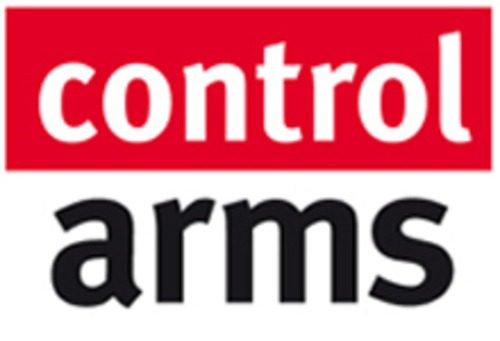Today at the United Nations in New York, we have been part of making history.
155 governments including Australia have just voted yes to a ground-breaking Arms Trade Treaty to curb the irresponsible arms trade that every day claims 1,500 lives. The global agreement on this treaty has finally sent a clear signal to gunrunners and human rights abusers that they cannot obtain and use weapons with impunity.
But today’s success wasn’t always guaranteed. When Oxfam, Amnesty and the International Action Network on Small Arms (IANSA) began the Control Arms Campaign in 2003, the only countries willing to support the treaty were Mali, Cambodia and Costa Rica. Most countries dismissed the idea as an idealistic NGO fantasy.
How did this remarkable turnaround happen? See the timeline below and watch this video to learn more about the Control Arms Campaign strategy and history.
How the Arms Trade Treaty was born: A timeline
- 1997 – Oscar Arias, the former President of Costa Rica, joins with other Nobel Peace Laureates, supported by NGOs, to develop an International Code of Conduct on international arms transfers.
- 2000 – NGOs, with the help of international legal experts, develop the Code of Conduct into the first draft “Framework Convention on International Arms Transfers”. NGOs begin to seek support for the Convention among global civil society and governments.
- 2003 – Oxfam, Amnesty and IANSA launch the Control Arms Campaign to push world governments to begin negotiating the Framework Convention on International Arms Transfers, now re-dubbed “the Arms Trade Treaty”. The campaign makes a compelling case for tough rules on the international arms trade. It launches in over 100 countries around the world, alongside the “Million Faces” online photo petition.
- 2005 – We start to see the impact of the Control Arms Campaign. By 2005, more than 50 governments support the Arms Trade Treaty.
- 2006 – The Million Faces petition, including photos of one million people around the world demanding an Arms Trade Treaty, is handed over to UN Secretary-General Kofi Annan. Seven countries, including Australia, co-author a UN General Assembly resolution to begin work on an Arms Trade Treaty at the UN.
- In December, an overwhelming majority of UN Member States (153) vote for a UN process towards the establishment of an Arms Trade Treaty – only the United States votes against the resolution.
- 2007 – Oxfam research demonstrates the tragic impact of the unregulated arms trade across the African continent, resulting conflict and armed violence that cost $18bn per year
- 2008 – The UN General Assembly Open-Ended Working Group begins considering aspects of a future Arms Trade Treaty. Oxfam research shows experts how irresponsible arms transfers undermine development goals.
- 2009 – The US Government reverses its former opposition and begins to support the Arms Trade Treaty and the UN General Assembly is able to agree a timeframe for formal negotiations. The agreement includes four preparatory meetings between 2010 and 2012, and a final negotiating conference in July 2012.
- 2010–2012 – Control Arms campaigners including Oxfam Australia’s Ben Murphy and Pacific peace activities like Ema Tagicakibau make several trips to New York to attend the treaty negotiations and make sure the concerns of people affected by armed violence are heard.
- 2012 – At the beginning of the ‘final’ negotiating conference Control Arms campaigners present UN Secretary General Ban Ki-Moon with a petition of over 500,000 voices calling on all world governments to secure a strong treaty.
- Governments develop a draft treaty at the conference but fail to adopt it after the United States, followed by Russia and others request more time for negotiations. Oxfam calls on Australia to play a key role in getting the treaty negotiations back on track.
- In November, 157 UN Member States vote in favour of a final (FINAL!) UN Conference on the Arms Trade Treaty. Oxfam urges governments to finish the job.
- March 2013 – The FINAL negotiating conference, now presided over by Australian diplomat Peter Woolcott, begins in New York. Strong improvements are made to the treaty text and on the penultimate day it seems the overwhelming majority of world governments support it. However, in the final hours, a consensus outcome is blocked by just 3 countries – Iran, Syria and North Korea.
- A group of 12 countries including Australia immediately respond with a proposal to take the draft Treaty text, attached to a new resolution, to the UN General Assembly for passage via a two-thirds majority vote. The Oxfam urges states to “Vote Yes” to the Treaty!
- Tuesday 2 April, 2013 – more than 90 countries co-sponsor a new resolution in the UN General Assembly to adopt the Arms Trade Treaty. The resolution passes in a sweeping victory – 155 in favour, 22 abstentions and only 3 countries opposed – Iran, Syria and North Korea. WE WON!!
- June 3, 2013 – The Arms Trade Treaty will be opened for signature by all UN member states.
We have come to the end of this chapter in the global campaign for a strong and effective Arms Trade Treaty. Ensuring that countries ratify and implement the Arms Trade Treaty will be vital in order to translate the words of the treaty into action that saves lives.
But for now, we celebrate the success of this monumental step forward! Thanks to millions of people like you lending your signatures, faces, and tweets, the Arms Trade Treaty is now a reality. Today we have made history!
Ben Murphy and Steph Cousins, Humanitarian Advocacy for Oxfam Australia
Get Involved
Keep up to date with all our work by signing up to our free e-newsletters.
Help us continue this and other important work around the world by making a donation today.

